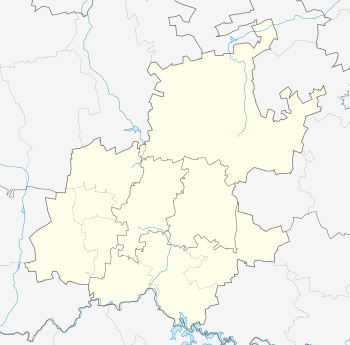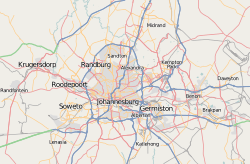Newtown, Johannesburg
| Newtown | |
|---|---|
.jpg) Jeppe Street, Newtown, Johannesburg | |
 Newtown | |
|
Location within Greater Johannesburg  Newtown  Newtown Newtown (South Africa)  Newtown Newtown (Africa) | |
| Coordinates: 26°12′14″S 28°02′02″E / 26.204°S 28.034°ECoordinates: 26°12′14″S 28°02′02″E / 26.204°S 28.034°E | |
| Country | South Africa |
| Province | Gauteng |
| Municipality | City of Johannesburg |
| Main Place | Johannesburg |
| Area[1] | |
| • Total | 0.85 km2 (0.33 sq mi) |
| Population (2011)[1] | |
| • Total | 2,505 |
| • Density | 2,900/km2 (7,600/sq mi) |
| Racial makeup (2011)[1] | |
| • Black African | 90.0% |
| • Coloured | 1.9% |
| • Indian/Asian | 6.4% |
| • White | 1.2% |
| • Other | 0.6% |
| First languages (2011)[1] | |
| • Zulu | 20.9% |
| • English | 12.5% |
| • Tswana | 10.0% |
| • Northern Sotho | 8.1% |
| • Other | 48.6% |
| Time zone | UTC+2 (SAST) |
| Postal code (street) | 8420 |
| PO box | 8420 |
Newtown is a suburb of Johannesburg, South Africa. It is located in Region F of the City of Johannesburg Metropolitan Municipality and is one of five tourism developments aimed at inner-city regeneration.
Historical background
At the turn of the 20th century, the Newtown Precinct was known as "the Brickfields". This area was rich in clay, and brick making became the most popular form of generating income. By 1896, about 7,000 people of all races lived in the area, later named Burghersdorp.
As this land was close to the centre of Johannesburg and the railway line, many businesses and immigrants coming from overseas bought stands in Burghersdorp. Soon, trading companies, banks, brick companies, a brewery, and fisheries moved into the area.
In April 1904, the fire brigade set the area alight destroying everything in the inferno - a measure allegedly to combat the bubonic plague that had broken out. The area was surveyed, re-planned in unbecoming haste and renamed Newtown by October 1904, a commercial area where vast fortunes in milling, production of sugar and food merchandising would be made.
Cleanup
As with major cities in some regions of the world, Johannesburg's city centre has been through a period of stagnation and degeneration. However, in the past few years a number of initiatives have been adopted to reverse these trends. One of the most important of these is the Greater Newtown Development.
The establishment of a City Improvement District, the installation of closed-circuit TV (CCTV), the upgrading of existing buildings and public open spaces have turned Newtown into a safe, secure and attractive environment. Mary Fitzgerald Square regularly hosts public performances and gatherings. With lighting designed by renowned French lighting designer, Patrick Rimoux, Newtown has been transformed into a well-lit, attractive destination.
Regeneration
In partnership with Gauteng Agency Blue IQ, the Johannesburg City Council - through the Johannesburg Development Agency - is transforming Newtown into a safe and attractive place to work, live and visit. The project entails several improvements of the area, all aimed at enchancing Newtown and making it viable. These include five housing developments catering for different income levels.
Over 2,000 housing units will be built over the next three years. This destination has been made accessible through the construction of the Nelson Mandela Bridge and associated M1/Carr Street interchange. The Nelson Mandela Bridge opened on 20 July 2003 and has become the new gateway from the north into Newtown.
Location
Located in the western sector of the Johannesburg city centre, Newtown covers an area that stretches from the marshalling yards and railway lines to the north, the M2 motorway in the south, West Street in the east and Quinn Street in the west.
This destination is now easier to reach with the construction of the Nelson Mandela Bridge and associated N1 / Carr Street interchange, co-funded by Blue IQ, the City of Johannesburg, National Roads Agency and the National Department of Transport.
Newtown has now become synonymous with the heritage and culture of South Africa and especially Johannesburg.
References
| Wikimedia Commons has media related to Newtown, Johannesburg. |
- 1 2 3 4 "Sub Place Newtown". Census 2011.